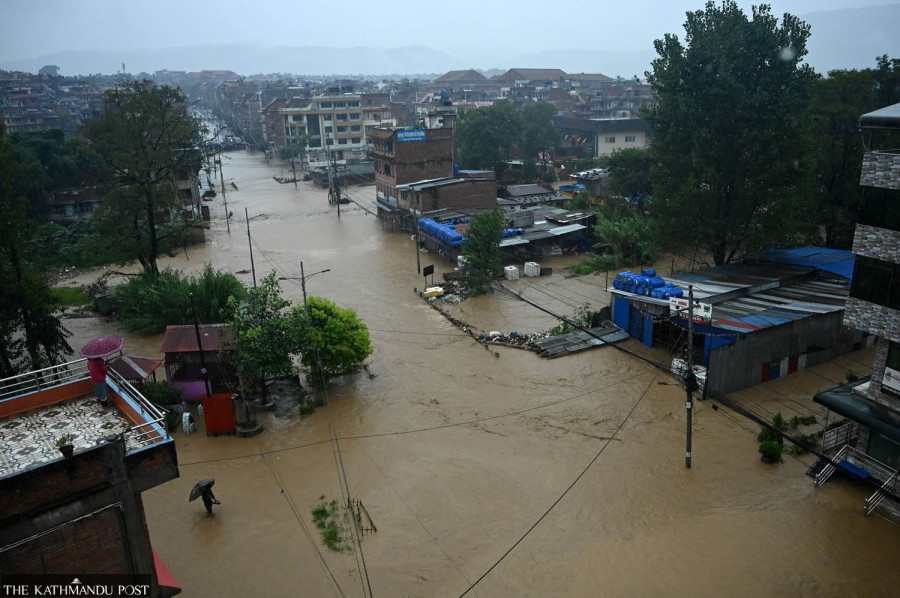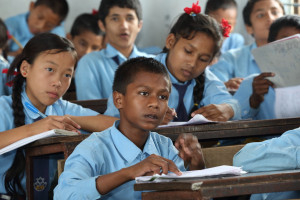Columns
Nepal floods: A preventable disaster
With better planning, stronger systems and informed communities, we can reform our action plan.
Shristi Manandhar
Nisha (name changed), a resident of Sanchal, Sanepa, whose home was flooded twice in 2024, recalls, “We didn’t even get a warning. We didn’t know who to reach out to.” As floodwater surged through her house, she and her father were forced to cut off the power supply to avoid electrocution. Trapped on the terrace, they watched in horror as seven of their neighbours, including children, were nearly swept away, only to be saved by the single person who could swim. “We felt completely abandoned,” Nisha says. “No one came, not even from the ward office.” Even now, the fear of flooding lingers. “Despite what happened, we are still living in the same house. And with news that this year’s rainfall might be even heavier, we’re living in fear of having to relive the experience,” she shared.
Unfortunately, stories like this are increasingly common, not just in Kathmandu, but across the country, where floods have caused devastating damage and, in some tragic cases, resulted in loss of lives. These stories are a scary reminder of what is at stake. It also reflects the government’s inaction despite having crucial data ahead of these disasters.
These flash floods along the banks of the Bagmati River in Kathmandu, Roshi Khola of Kavrepalanchok district, and several other regions also expose Nepal’s vulnerability to water-induced disasters. The images of washed-away roads, people fleeing their homes and fatalities are no longer rare or isolated. Reported incidences of flooding in Nepal have quadrupled from 97 to 414 within the span of just a few years, largely due to erratic rainfall patterns driven by a warming planet. An important question we must ask now is this: How long will we allow ourselves to get caught unprepared?
Nepal has consistently been ranked as one of the world’s most disaster-prone countries, with steep terrain, fragile slopes, and glacier-fed rivers. In 2019, the government’s Disaster Risk Reduction Report stated that over 80 percent of Nepal’s total population is directly or indirectly exposed to various risks and hazards, with floods being among the most frequent and deadly. Yet our national response is largely reactive. Floods have continued to be treated as seasonal problems when, in reality, they also occur due to serious structural issues that require long-term planning, preparedness, and risk reduction measures.
One of the most critical gaps in flood preparedness is the lack of an effective early warning system. While basic alert systems exist for some river basins in Nepal, many more disaster-prone areas remain unprotected. Only a small number of families receive warnings from these systems and often just minutes before disaster strikes.
In August 2022, 486,000 SMS alerts that Nepal Telecom sent around were limited to people living in areas that were already affected, meaning many at-risk communities received no proactive warning. In the Bhote Koshi basin, early warning systems installed by a hydropower company offer evacuation notice to the 79 villages that live downstream just five to eight minutes before a flood, leaving insufficient time for efficient evacuation. In earlier flooding cases, during 2014’s Babai River basin floods in Bardiya, a tragic breakdown in communication kept authorities from reacting in time to upstream flood warnings. More than 100 people lost their lives, despite early alerts from the gauge reader.
The 2020 Copernicus report, which studied Nepal’s flood early warning system, highlighted that even seemingly simple solutions like SMS alerts and sirens can save many lives. But these systems need to be expanded, maintained, and paired with rigorous community-level training so that people know exactly how to respond. And this is not just limited to the monsoons, but throughout the year, during other potential natural disasters such as landslides and Glacial Lake Outburst Floods (GLOF). Settlements along river banks, poor urban planning, unlawful extractions of river-based material and deforestation—all contribute to heightened risks of floods. Reversing this trend requires a combination of policy-level changes that prohibit construction in high-risk zones and nature-based solutions such as wetland restoration, river corridor protection and native vegetation revival.
The impact of floods goes far beyond just damaging infrastructure. They destroy crops, displace entire communities, interrupt education and significantly increase public health risks. Large segments of entire communities are often cut off from basic services. Relief efforts are also often delayed, with insufficient support provided to the community.
In October last year, the Humanitarian Data Analysis team at Togglecorp processed secondary data using the Data Entry and Exploration Platform software (DEEP) to shed light on the broader impacts of floods. The result, Nepal Flood: Multi-Sectoral Impact Report, analysed data from diverse sources, ranging from local news sources, government sites and evidence found in humanitarian situation reports, flash updates and other assessment reports. The report analysed not just the physical destruction caused by the floods, but also long-term social and economic effects as well.
The findings were grim and the numbers jarring. The floods had a significant impact on Nepal’s health sector. Of the 62 health facilities that were affected, 49 had already been operating at limited capacity. As families crowded into temporary shelters with unsafe water, their vulnerability to diseases such as cholera and dengue shot up. The education sector was badly hit. One hundred and ninety schools were impacted, with over 23,560 children affected. Of this number, over 10,000 students lost access to safe learning environments. More than 4,000 houses were completely damaged, with over 5,300 houses reporting partial damage.
The losses were staggering in the agricultural sector. Over 46,500 hectares of paddy fields were flooded in the Madhesh alone. More than 26,000 livestock were lost nationwide. Damage to fruit and vegetable farms, and fish ponds caused an additional Rs1.13 billion in losses and pushed the total agricultural losses above Rs6 billion. In the Water, Sanitation and Hygiene sector, over 520 water supply systems were damaged, resulting in a financial loss of Rs3.55 billion, leaving large towns like Panauti without drinking water for a long time.
In terms of logistics and infrastructure, 44 suspension bridges, 22 hydropower plants, 37 highways and 312 telecom sites were disrupted, isolating communities and hampering essential response efforts. In Panauti alone, more than 500 homes were destroyed and more than 700 families were displaced. Unfortunately, this is just the tip of the iceberg regarding losses. Any person who has faced any disaster will understand that the longer-term costs, which are less visible, are those of emotional trauma, developmental loss, disease and disrupted livelihoods. It is the kind of loss that affects not just one person but compounds across several generations.
As this year’s monsoon batters down the country with forecasts warning of heavier-than-average rainfall, Nepal stands at a crossroads once again. We know what is coming and we know what needs to be done. We must stop viewing floods as one-time events. Creating safe and sustainable communities with coordinated efforts, robust early warning systems and clear accountability is fundamental to everyone’s safety. We must hold our local leaders and planners responsible toward creating a safe and sustainable environment.
Floods will continue to test us. But with better planning, stronger systems and informed communities, we can reform our action plan. Let’s stop accepting floods as inevitable. Let’s treat them as what they truly are: Preventable.




 10.12°C Kathmandu
10.12°C Kathmandu













%20(1).jpg&w=300&height=200)

